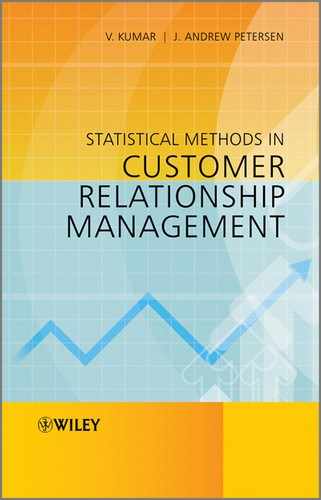C.3 VAR Models: How to Capture the Dynamics in a System of Variables?
The third step in persistence modeling is to specify a VAR model to link the (short-run) movements of the different variables under consideration. Depending on the outcomes of the proceeding unit-root and cointegration tests, these VAR models are specified in the levels (no unit roots), in the differences (unit roots without cointegration), or in error-correction format (cointegration).
For expository purposes, we first consider a model in levels, and focus on a simple three-equation model linking own sales performance (S), own marketing spending (M), and competitive marketing spending (CM). The corresponding VAR model (in which, for ease of notation, all deterministic components are omitted) becomes
where ![]() is the order of the model, and where vector u is
is the order of the model, and where vector u is ![]()
This specification is very flexible, and reflects the forces or channels of influence discussed earlier: delayed response ![]() , purchase reinforcement (
, purchase reinforcement (![]() ), performance feedback (
), performance feedback (![]() ), inertia in decision making (
), inertia in decision making (![]() ), and competitive reactions (
), and competitive reactions (![]() ). Only instantaneous effects are not included directly, but these are reflected in the variance–covariance matrix of the residuals (
). Only instantaneous effects are not included directly, but these are reflected in the variance–covariance matrix of the residuals (![]() ). Estimation of these models is straightforward: (a) all explanatory variables are predetermined, so there is no concern over the identification issues that are often encountered when specifying structural multiple-equation models; and (b) all equations in the system have the same explanatory variables so that OLS estimation can be applied without loss of efficiency.
). Estimation of these models is straightforward: (a) all explanatory variables are predetermined, so there is no concern over the identification issues that are often encountered when specifying structural multiple-equation models; and (b) all equations in the system have the same explanatory variables so that OLS estimation can be applied without loss of efficiency.
However, this flexibility comes at a certain cost. First, the number of parameters may become exuberant. For ![]() , for example, the VAR model in Equation C.8 will estimate 9 × 8 = 72 autoregressive parameters. If, however, one considers a system with five endogenous variables, this number increases to 25 × 8 = 200. As a consequence, VAR modelers typically do not interpret the individual parameters themselves, but rather focus on the impulse-response functions (IRFs) derived from these parameters. IRFs trace, over time, the incremental performance and spending implications of an initial one-period change in one of the support variables. In so doing, they provide a concise summary of the information contained in this multitude of parameters, a summary that lends itself well to a graphical and easy-to-interpret representation.
, for example, the VAR model in Equation C.8 will estimate 9 × 8 = 72 autoregressive parameters. If, however, one considers a system with five endogenous variables, this number increases to 25 × 8 = 200. As a consequence, VAR modelers typically do not interpret the individual parameters themselves, but rather focus on the impulse-response functions (IRFs) derived from these parameters. IRFs trace, over time, the incremental performance and spending implications of an initial one-period change in one of the support variables. In so doing, they provide a concise summary of the information contained in this multitude of parameters, a summary that lends itself well to a graphical and easy-to-interpret representation.
Second, no direct estimate is provided of the instantaneous effects. The residual correlation matrix can be used to establish the presence of such an effect, but not its direction. Various procedures have been used in the marketing literature to deal with this issue, and readers may refer to Dekimpe and Hanssens [1] for a brief review.
If some of the variable have a unit root, the VAR in Equation C.8 is specified in the differences; for example, ![]() are replaced by
are replaced by ![]() . If the variables are cointegrated as well, this model in differences is augmented with the lagged residuals of the respective long-run equilibrium relationships, resulting in the following specification:
. If the variables are cointegrated as well, this model in differences is augmented with the lagged residuals of the respective long-run equilibrium relationships, resulting in the following specification:
(C.9) 
The addition of the error-correction terms ![]() implies that in every period there is a partial adjustment toward restoring the underlying, temporarily distributed, long-run equilibrium. Put differently, the system partially corrects for the previously observed deviations
implies that in every period there is a partial adjustment toward restoring the underlying, temporarily distributed, long-run equilibrium. Put differently, the system partially corrects for the previously observed deviations ![]() , and the respective
, and the respective ![]() coefficients reflect the speed of adjustment of the corresponding dependent variable toward the equilibrium. A good review of the implementation issues involved can be found in Franses and Paap [5].
coefficients reflect the speed of adjustment of the corresponding dependent variable toward the equilibrium. A good review of the implementation issues involved can be found in Franses and Paap [5].

